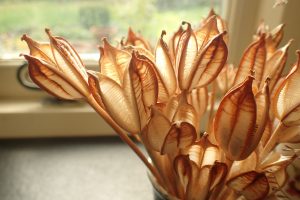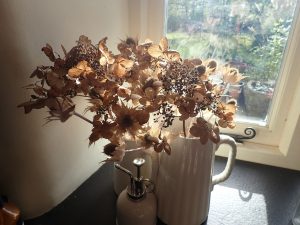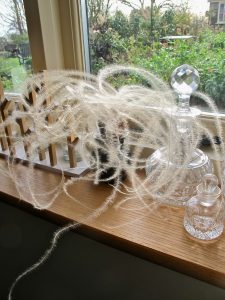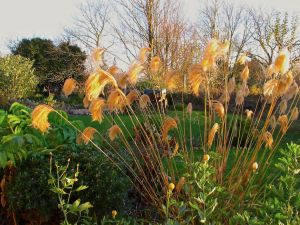It’s that time of year. The garden’s winding down and most of my roses have finished for the year so there are very few to pick for the house. I’ve already reduced the top growth of most by a third, to prevent the wind from rocking the plant about and creating a gaping hole above the roots. If I allowed that to happen, water would funnel down and freeze around the roots with disastrous consequences. One of two of my roses are still defying the elements though, and I always fall in love with ‘Pearl Drift’ again at this time of year. There was a danger that this 1980s rose bred by Bill le Grice might become unavailable, but I’m delighted to say that major rose growers are still supplying this beauty. In summer the flowers look a bland pearl-white, but by late autumn this free-flowering rose has a late flush of wide-open, fragrant semi-double blooms displayed above the healthy, handsome foliage. As the sun sinks lower, day by day, they’re the last reminder of summer now gone and they send a shiver of pleasure down my spine.
Soon they’ll be nothing left to pick at all. Thankfully I harvested some flowers and seedheads earlier this year. They’re arranged in small vases on the kitchen windowsill and that low sun I mentioned earlier is creating its own special magic, just as it did with ‘Pearl Drift’. There’s a cluster of goblet-shaped seedheads from a burnished-red species tulip named Tulipa sprengeri. The stems are marked in brown Morse code dots and dashes and there are three spear-shaped seed cases. These parchment cases are margined, mid-ribbed and fine-lined in conker-brown. Each one is a miniature work of art, especially when low sunlight shines through.

Tulipa sprengeri is the last tulip to flower, so there’s plenty of sumptuous foliage to flatter the burnished tomato-red flowers when it finally does its thing in mid-May or early June. The flowers are modest in size, but all the better for it, and the foliage is a shiny bright-green so there’s a jewel box effect to this late bulb. This species tulip, originally found in Amasya in North Turkey but now extinct, only has two Latin names. There is no name in single italics. If you have bulbs with this sort of binomial Latin name, eg Scilla siberica or Fritillaria pyrenaica, they are species not hybrids. They will reproduce from seeds true to type and rarely produce many offsets. Should you follow the common mantra to ‘deadhead after flowering, these species bulbs will fail to multiply. Leave them to their own devices and they’ll reward you with more!
Tulipa sprengeri is uber-expensive to buy as a bulb and it’s hard to find too, although Avon Bulbs do have it. Chiltern Seeds and others sell the seeds and it is very willing to grow from seed, especially in semi-shade, taking roughly four years to produce flowers. I sprinkle my seed son to the ground. My established bulbs shed their seeds in August or thereabouts, leaving the stiff stems and empty husks behind. They scatter themselves, although I do sprinkle some about as well. Each head contains hundreds of seeds and I have a friend who grows it in grass under a tree and she deadheads it to prevent too many. Can one have too many Tulipa sprengeri? I think not!
Alliums also make good seedheads, but you must cut them before the black seeds begin to rattle. Exploding seedheads are bad news and my first foray into dried flowers did not go well. I picked the brown slender heads of the plant commonly called bullrushes. It is in fact Great reedmace (Typha latifolia). The velvet-brown candles looked wonderful in my porch, until they exploded into a haze of fine cotton wool.

My kitchen windowsill also contains eryngium seedheads and these are from another willing, or should that be over-willing, self-seeder named Eryngium giganteum. This is Miss Willmott’s Ghost. This steely biennial that has taken hold of my garden rather too well. It has the best seedhead though, a large oval thimble surrounded by an unbroken ruff of jagged bracts. One of my granddaughters refers to it as the ‘prickly plant’. I prefer this stainless-steel sea holly to any other, because the stems and flowers are silvery rather than blue. The steely branching stems produce flowers of different sizes and these need to be cut just when they develop a touch of parchment-brown. This way they hang on to their seeds. Do not wait until they turn brown, because they’ll shed their load just like those bullrushes in my long-gone porch.

I’ve mixed my eryngiums with lacecap hydrangea heads and these have larger florets, or false flowers radiating round the edges. I’m too cold and dry to grow the seaside Hydrangea macrophylla with its pink and blue dome of flowers. Instead, I grow some later-flowering forms of Hydrangea paniculata, an easier hydrangea for most. I have ‘Wim’s Red’ in a container and the heads turn red in autumn before going mink-brown. The smaller flowers form a conical shape, similar to lilac, but there are several larger false flowers radiating outwards and these are held on wiry longer stems. This arrangement allows the flowers to swoon artistically downwards. They provide a languid contrast to the upright, almost military bracts of the sea holly flowers. I grow two ‘paniculatas’ in the woodland border. One is ‘Limelight’, the other a dainty beauty called ‘Kyushu’. Mostly early flowers and ferns.
One of my star drought-tolerant performers this year was a perennial sea lavender, Limonium platyphyllum. There are named forms of this. Beth Chatto sells a darker shorter form, ‘Violetta’. ‘Robert Butler’ is also shorter, with fuller lavender flowers. ‘Dazzle Rocks’ is another shorter one. Mine is the bog-standard one with tall stems topped with airy small flowers in pale-lavender. The flowers mature to form arching stems of small tufted beige-pink flowers and these make a wonderful froth, just like lapping waves on a seashore. They add movement as the stems arch and bend. These perennial sea lavenders should not be confused with that brightly coloured annual statice, Limonium sinuatum. The dried flowers I love must match the winter palette of greys, silvers and browns.

Perhaps my favourite is a feathery grass named Stipa barbata. This early-season grass peaks in July, when the foot-long feathery heads flail around. As summer wears on, the heads detach themselves and there’s a quill-like end that drills into the ground because moisture makes the stems into tight corkscrews. Stipas like warmth, so this needs a hot spot in the garden. It’s short-lived and tricky to buy, although Beth Chatto stocked it this summer. You need to catch this before the stems take off and I find myself running my hands through this grass. When the feathery heads come away it’s ready. I sow some straight away, by plunging the sharp bits into moist and gritty horticultural sand. The rest go on the windowsill to remind me that summer will come again – one day. I’ll also collect heads from the annual barley-like Hordeum jubatum along with the feathery rabbit tails of Pennisetum orientale. I can rarely get this grass through one of my winters, because it needs better drainage than Cold Aston can supply, so I treat it as an annual more or less.

My most spectacular winter grass is another that needs good winter drainage, Miscanthus nepalensis. It’s obviously from Nepal as the name suggests, but it grows on water-shedding slopes and the majority of rainfall comes in summer and not winter. A lot of Asian plants prefer summer rainfall, to emulate their six-week rainy season, followed by a dry, cold winter. My garden (and probably yours) offers the complete reverse because summers are getting drier and winters are deluged by heavy bursts of rainfall. It isn’t cold that kills plants in winter, it’s wet roots. I have placed Miscanthus nepalensis in a warm position close to my south-facing cottage wall in hopes that it will survive. I do get seedlings. One is in a trough of Cyclamen coum and another has popped up in a container planted up with clematis and bulbs.
The sensible solution is to grow this spectacular grass in a container and take it into your unheated greenhouse over winter, as you would an agapanthus. This Afghan hound of a grass carries the eye to a pampas grass beyond and I’ve planted Pennisetum macrourum closer to the house, so the three join up.
My Christmas list for this year contains a crystal ball, in order to predict the erratic weather we seem to get these days. I’m also after a metal detector, so that I can find my secateurs when I lose them. I’ll never have to upend the green bin again! It’s not easy when you’re short.



